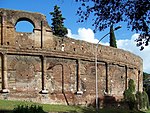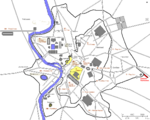Aqua Anio Novus
1st-century establishments in Italy50s establishments in the Roman Empire52 establishmentsAncient Roman aqueducts in RomeBuildings and structures completed in the 1st century ... and 2 more
CaligulaClaudius

Aqua Anio Novus (Latin for "New Anio aqueduct") was an ancient Roman aqueduct. Like the Aqua Claudia, it was begun by emperor Caligula in 38 AD and completed in 52 AD by Claudius, who dedicated them both on August 1. Together with the Aqua Anio Vetus, Aqua Marcia and Aqua Claudia, it is regarded as one of the "four great aqueducts of Rome."
Excerpt from the Wikipedia article Aqua Anio Novus (License: CC BY-SA 3.0, Authors, Images).Aqua Anio Novus
Piazzale Labicano, Rome Municipio Roma VII
Geographical coordinates (GPS) Address Nearby Places Show on map
Geographical coordinates (GPS)
| Latitude | Longitude |
|---|---|
| N 41.891388888889 ° | E 12.515277777778 ° |
Address
Sepolcro del fornaio Eurisace
Piazzale Labicano
00182 Rome, Municipio Roma VII
Lazio, Italy
Open on Google Maps









